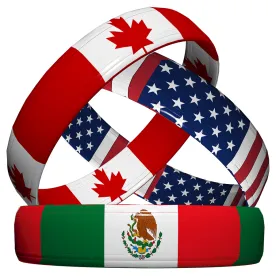NAFTA boosted the centuries-old business relationship between Mexico and the United States by allowing both countries to benefit from a seamless workshop that undoubtedly made the pie larger. As with any 25-year-old contract, however, NAFTA needed to be revised. Negotiations required delicate balancing between technical and political issues, with motor vehicles and auto parts requiring the lion´s share of the modifications.
In this article, we take stock of the revised agreement and, at the same time, look ahead at what the 2019 business calendar may bring in Mexico through the following top four issues:
- The (possible) execution of the US-Mexico-Canada Trade Agreement (USMCA), and what it means, particularly, for motor vehicles and auto parts manufacturing and sales in North America
- The newly elected (2018-2024) Lopez-Obrador administration
- New Product Safety Requirements and Recall Procedures
- The New Mexican Anti-corruption Law
With a population of roughly 40 percent of that of the U.S. (126 million) and a territory close to three times the size of Texas, Mexico is the 11th largest economy in the world. It has a network of 12 Free Trade Agreements (FTAs) with 46 countries, and nine more will be added with the renewed Trans-Pacific Partnership (TPP), from which the U.S. withdrew. In the past several years, it has also begun building upon its automobile manufacturing experience to launch an aerospace industry.
In addition, Mexico (i) was either the first (6 States) or second (22 States) largest export market for 28 states in the U.S. in 2018, (ii) is the U.S.’ second-largest export market, and third-largest source of imports, (iii) has a growing middle class that is eager and able to purchase American goods and services, (iv) is a reliable and experienced manufacturing and trading partner, and (v) will benefit from a demographic bonus during the next several years - in comparison with the U.S. population, which is aging more rapidly.
1. The (Possible) Execution of the USMCA, and What it Means, Particularly, for Motor Vehicles and Auto Parts Manufacturing and Sales in North America
The USMCA, signed by presidents Trump and Peña-Nieto, and Prime Minister Justin Trudeau on November 30, 2018, is making its way through the legislative process in each country. The 2018 U.S. election brought a Democratic majority into the House of Representatives, which is now asking for modifications to what was negotiated, particularly in its labor and environmental provisions.
In response, the Trump administration has announced that it is considering starting the six-month withdrawal process from NAFTA (this could very well have already begun when this article goes to print), as a way of pressuring Congress to vote on the USMCA as is, or risk having no treaty at all; such a situation would take trade in North America to “ordinary” (this is, no preferential commercial treatment) status under World Trade Organization (WTO) standards.
As for motor vehicles and auto parts manufacturing and sales in North America, the USMCA - if approved - will mark a transformation from a simple, straightforward compliance-or-not of the relevant Rule of Origin (ROO) into a complex tracing system of production for motor vehicles in which not only a more stringent Rule of Origin will have to be fulfilled (from 62.5 percent to 75 percent in a five-year transition period), but 70 percent of steel and aluminum should be sourced within the NAFTA region, and 40 percent of its manufacturing would have to be made with labor of US $16-an-hour or above; we should note, though, that the aforementioned requisites are already fulfilled by 68 percent of current motor vehicle exports, as per former Mexican Secretary of Economy Ildefonso Guajardo. (Of course, this summary does not cover the many details that are relevant, nor does it touch upon the new classification of auto parts into several, highly-detailed lists that range from “super core” to “complimentary” parts. For a detailed analysis, see here).
If the six-month period lapses and the U.S. withdraws from NAFTA, overall trade within North America would go back to its WTO treatment; this is, without the trade facilitation environment that we have grown accustomed to under NAFTA, namely the tariff-free exchange of goods, no Customs processing fees, preferential dispute settlement procedures, etc. Most importantly, tariffs would automatically go back up, say, from 2.5 percent for motor vehicles to 25 percent for light trucks (the placement of a dot certainly makes a lot of difference, from 2.5 percent to 25 percent). If NAFTA withdrawal occurs, the entire universe of goods and services that is currently exchanged duty-free would go back to paying tariffs; it is certainly advisable for your company to look into that right away and envision a possible scenario that may be only six months away, a task with which Foley can certainly help.
2. The Newly Elected (2018-2024) Lopez-Obrador Administration
After running – and losing - in the past three Federal Elections, once every six years, former Mexico City Mayor Andres Manuel Lopez-Obrador (usually referred to by the acronym AMLO) was elected President of Mexico. He has summarized his platform as a fight against corruption and impunity, through which he expects to have a large sum of resources to redirect to the less privileged people and geographical areas within Mexico. We have yet to see how he moves, if at all, from merely redistributing resources to fostering the creation of wealth.
A left-leaning nationalist, Lopez-Obrador relies on Mexico being self-sufficient in certain crops (corn, rice, wheat, and beans), in revamping oil production and refining, and in investing in certain infrastructure projects, such as the Mayan Peninsula and Pacific-to-Atlantic railways, though he bluntly announced recently that the new Mexico City airport currently under construction would be canceled, sending a terrible signal to the financial markets.
AMLO has offered not to increase taxes during his tenure, and has even announced the creation of a Free Trade Zone on the Mexican side of its border with the U.S., which would reduce Value Added (8 percent) and Income (20 percent) taxes, and increase minimum salaries, along with gasoline and energy prices to match those in the U.S. (final details will be available when the program is eventually approved by the Mexican Congress).
He has criticized former President Pena Nieto´s so-called 2014 Energy Reform but has signaled that there will be a three-year “trial period” so that current foreign investments can yield results.
Even though we do not anticipate AMLO´s administration requesting changes in the USMCA, if the U.S. withdraws from NAFTA, we foresee that Mexico will strengthen its internal (maquiladora-type) export promotion programs so that the “near-shore” advantage and manufacturing experience in complex (i.e., aerospace and motor vehicles) chains of production is not lost. This, as Lopez-Obrador, would likely not be willing to risk export-oriented manufacturing jobs that support a significant number of middle-class positions all across Mexico.
Despite what has been described above as to what may - or may not - happen in the very near future, there are certainties in Mexican business life that need to be addressed. We now touch upon a couple of lesser-known obligations that are present as you read this, applicable to all types of businesses currently operating in Mexico.
3. New Product Safety Requirements and Recall Procedures
Companies that manufacture or sell in Mexico should by now be fully familiar with mandatory recall procedures and class actions that are applicable in the country.
The Mexican Consumer Protection Agency (known as PROFECO) can now: (i) remove or call for repairing defective and insecure products, (ii) open investigations on product safety concerns, and (iii) impose relevant sanctions on manufacturing companies in Mexico that do not comply with product safety standards, or that otherwise could harm the life, safety or health of consumers.
Companies should preventively determine how to quickly react in case of a product safety or class action crisis in Mexico, and how to implement proper recall procedures compliant with Mexican law. It is also advisable for companies that manufacture in or import into Mexico to review compliance with the numerous Mexican mandatory standards (NOM, Normas Oficiales Mexicanas) that exist in the country.
4. New Mexican Anti-corruption Law
Beginning in July 2017, companies and individual employees that commit “serious administrative offenses” (bribery, collusion in public biddings, influence peddling, etc.) can be sanctioned with fines of up to two times the acquired benefits, damages, and lost profits, as well as being temporarily disqualified from participating in public bids; fines can go up to US $6 million.
A company´s liability may be reduced by implementing a compliance program, known as an “integrity policy.” Elements of such a policy are reasonably familiar to U.S. businesses and should include (i) organizational and procedural manuals, (ii) a published and distributed code of conduct, (iii) adequate whistleblower and reporting systems, and (iv) training programs, among others. Self-disclosure with authorities is also fostered.
As discussed above, President´s Lopez-Obrador has identified fighting corruption as the top priority of his administration. In fact, he was elected largely due to that constant offering, which met the demands of a lot of Mexicans, so we anticipate that these anti-corruption provisions will be enforced vigorously.





 />i
/>i
